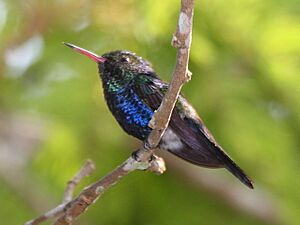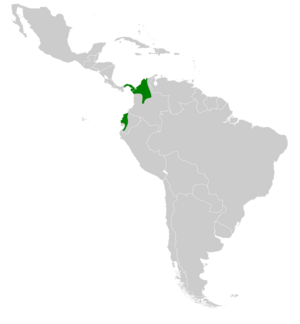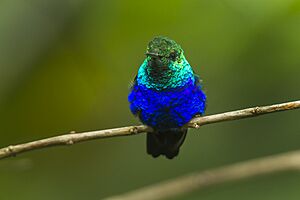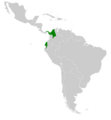Violet-bellied hummingbird facts for kids
Quick facts for kids Violet-bellied hummingbird |
|
|---|---|
 |
|
| Conservation status | |
| Scientific classification | |
 |
|
| Synonyms | |
|
Juliamyia julie, Damophila julie |
The violet-bellied hummingbird (Chlorestes julie) is a small, colorful hummingbird known for the male's bright, shimmering violet belly. These amazing birds are part of the hummingbird family, which is famous for its tiny size and super-fast wingbeats.
Contents
What is a Violet-bellied Hummingbird?
The scientific name for this bird is Chlorestes julie. It belongs to the Chlorestes group, which is part of the Trochilidae family. This family includes all hummingbirds. They are also part of a larger group called Apodiformes, which includes both hummingbirds and swifts.
Different Types of Violet-bellied Hummingbirds
There are three slightly different types, or subspecies, of the violet-bellied hummingbird:
- Chlorestes julie panamensis
- Chlorestes julie julie
- Chlorestes julie feliciana
These subspecies look very similar, with only tiny differences. For example, panamensis lives in Panama and has a dull green head. The julie and feliciana types both have shiny green backs. However, julie has a shorter bill (about 14.5 mm) and a bluer belly. Feliciana has a slightly longer bill (about 15.1 mm) and a more violet belly. You can find julie in Northern Colombia, while feliciana lives in western Ecuador and the very northwestern parts of Peru.
What Do They Look Like?
The violet-bellied hummingbird is known for the male's sparkling violet belly. The rest of its body is also very bright. Its back and head are a shiny metallic green.
Male and Female Differences
Male and female violet-bellied hummingbirds look different. This is called sexual dimorphism.
- Males are much brighter. Their chest and belly are a violet-blue. Their back, head, and throat are a metallic green. Their tail feathers are blue-black. Males are usually about 7.5 cm long and weigh around 3.4 grams.
- Females are not as colorful. Their back, head, and throat are a metallic bronze-green. But their belly is a pale gray, not bright violet. Their tail feathers can be blue-black or bluish-green, with pale gray tips. Females are typically about 7 cm long and weigh around 3.0 grams.
Young males look a bit like adult females. However, they might have some violet patches on their belly or a sparkling green neck.
Both male and female violet-bellied hummingbirds have long, rounded tails. They also have straight, short bills and pink lower parts of their bills.
What Sounds Do They Make?
Birds That Look Alike
Violet-bellied hummingbirds can sometimes be confused with other birds.
- Green-crowned woodnymphs look very similar in color and shape. They also live in the same areas. To tell them apart, look at their size, color, and tail. Violet-bellied hummingbirds are smaller. Their backs are green, not violet. Their tails are rounded, not notched. Green-crowned woodnymphs also have a violet color on the front of their head.
- The Sapphire-throated Hummingbird also has similar colors. But it has a blue throat, a green belly, and a notched tail.
Where Do They Live?
Violet-bellied hummingbirds live in central Panama, through Colombia, and down to southwestern Ecuador and the far northwestern part of Peru. Different types of these hummingbirds live in specific areas within this range. They do not move to different places during different seasons.
Their Home Environment
These hummingbirds like to live in the lower parts of humid forests where trees lose their leaves. They also live at the edges of forests and in areas where new trees are growing back.
How Do They Live?
Reproduction and Family Life
Like many hummingbirds, male violet-bellied hummingbirds mate with several females. The males try to attract females by singing from perches that are about 1 to 10 meters high. They might also fly in a 'U' shape in front of the females. After mating, the male leaves the female to raise the young birds by herself. These birds do not mate for life, and they do not live together in large groups.
Nests and Chicks
Female hummingbirds build the nests and take care of the babies. A female builds her nest from plant fibers, animal hair, and feathers. She places it in a bush or a tree, usually about 1.2 to 4.2 meters above the ground. She lays two small white eggs, each about 8 by 13 mm. She sits on the eggs for about 15 days to keep them warm. After hatching, the baby birds stay in the nest for 20 to 22 days. When they hatch, the chicks are very helpless and need their mother to feed and protect them. If they survive, violet-bellied hummingbirds can live for about 4.2 years.
What Do They Eat?
Violet-bellied hummingbirds mainly drink nectar from flowers. Nectar is a sweet liquid found in plants. They get nectar from plants like those in the Rubiaceae, Ericaceae, Gesneriaceae (like Besleria), and Fabaceae (like Inga) families. They also eat small insects and other tiny creatures. Male hummingbirds might protect their feeding areas from other males and large insects. Even though they don't live in flocks, they might gather at fruit trees or bird feeders. We don't know much about what animals hunt violet-bellied hummingbirds.
Are They in Danger?
The violet-bellied hummingbird is listed as "least concern" by the IUCN Red List. This means they are not currently threatened. They can live well even in areas that have been changed by humans, like forest edges.
Images for kids





